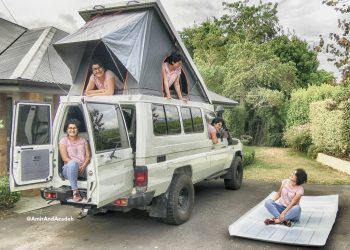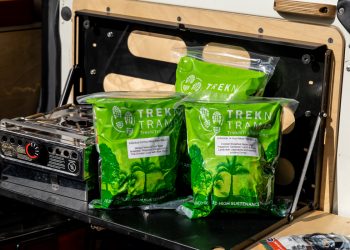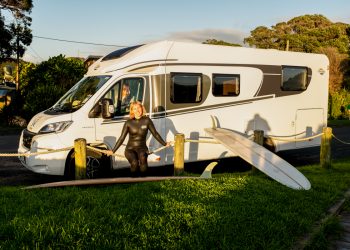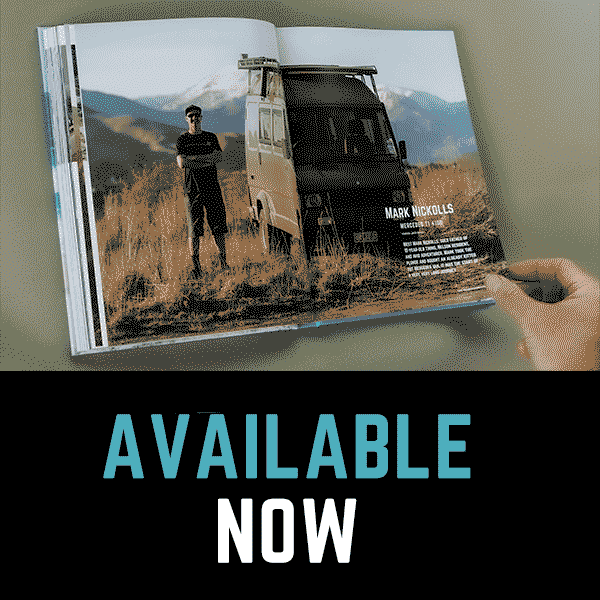Are you using a bunch of random off-casts from your home kitchen and other camping set ups? Are you tired of the waste of space your cookware takes up? Well we have some alternatives for you and the how and why of different cookware materials and coatings.
Cookware is probably one of those things that is a total after thought when you’re first getting into campers. But you need it, if you need it you gotta stow it and it’s got to do the job of heating.
There’s a wide variety of metals and even ceramics used in cookware.

Aluminium is used a lot in hiking cookware because of its lightness and strength, go on any camping web store and this will be the primary metal used. It’s really designed for stowing in a backpack and keeping things light when you’re tramping. Aluminium is a good heat conductor, in fact too good and this is why you get sticking points or hot spots in these pans. This type of cookware is great for re-heating package meals and simple stuff. It can leech with acidic foods [like your spag bol sauce, your baked beans etc] and give food that tinny taste.

Cast iron, the other end of the spectrum, is heavy duty thick metal. Because cast iron is a poor conductor of heat it offers as very good, even cooking surface. This is the sort of stuff most campers dream about, getting your seasoned cast iron skillet out on the embers of last night’s bonfire and frying up some bacon and eggs. Grabbing the dutch oven and whisking up some Damper.
Well that’s all good and makes for a nice instagram post… but here’s the rub, open fires are highly restricted in campgrounds if allowed at all and most of NZ over summer has an open fire ban. So even though we all probably dream of those scenarios, do you wanna be the one that burnt down half of the Nelson Lakes?
In short you can’t expect an open fire to be your primary source of heating/cooking, it’s a treat. So for the majority of time Cast Iron cookware is kind of an overkill. It’s bulky and it’s heavy. It does require seasoning to stop food sticking but that’s not difficult to do.
Tasha Gray; ‘Our cookware is either cast iron or stainless. I look for small, functional and materials that will last a long time.’

Stainless Steel is a good compromise of all the metals used. It’s the most common type of cookware. Stainless is also a terrible heat conductor, so most stainless steel cookware has a bonded bottom, basically there’s a thick disc of aluminium clad into the bottom to make a good cooking surface. Good quality stainless will have an 18/10 stamp on it that refers to the chromium/nickel mix of the metal used. Stainless of this quality will be low maintenance, pretty scratch proof, won’t leech that tinny taste and last your lifetime.
Non-Stick cookware in general a mix of metals. More often than not thick aluminium that then has a non stick coating added. It provides a healthy way of cooking because you’re reducing the amount of oil needed. Clean up in a camper is super easy.

Sam Roil‘It’s super pricey, but I just brought one of the Weber frying pans – non-stick, and it has a detachable handle which is mint for storage. I reckon non-stick for ease of cleanup when you’ve got limited water supply.
Non-Stick cookware does require it’s own approach, you can’t scratch or damage the coating in anyway, so you have to use silicone or wooden utensils. You also have to be careful how you store non-stick stuff, you can’t stack it in a camper because road vibrations will rub off the coating. Most non-stick sets come with silicone pads to inlay between each pot to combat this issue. The silicone pads double as heat mats.
PTFE is the “classic” nonstick material made famous by the brand Teflon. When overheated, PTFE coatings can break down and release gases. You can use PTFE cookware safely as long as you use it properly. 260 degrees C is the maximum temperature recommended for cooking with PTFE cookware… and even though that seems excessive your average lpg flame can go to 1800 degrees C… so yeah ummm, your call.
One of the biggest issues with pots and pans in a small space like a camper is their handles for both storing and using on a small cooker. There’s a host of brands producing cookware sets that have detachable, interchangeable handles. Most of these sets are nesting, which means they fit into each other like Babushka dolls.
One of these sets will see you right, but they are expensive! And most of us will be squirming at the idea of throwing down $200-$800 nzd for a cookware set that you aren’t using all the time
Leanne from Quirky Campers; ‘Well, from a Quirky perspective, we’re all about the finishing touches so Ivan has matching, nesting non-stick cookware with removable handles for space-saving. Given he has a three burner hob and oven, you can’t really just supply one pan 😉 But Ivan is top-end and I think you have to reflect the style and quality of the van.‘
The set Leanne uses is a NZ invention and readily available at places like Burnsco. It’s the Smartspace set that is square, further increasing storage space.
Me, what do I use? Like a lot campervan owners I started with a nice small nesting hiking camp set, it was super thin stainless with folding handles. Because it was so thin the heat transfer was uneven resulting in food catching. The handles felt flimsy and the plastic coating on the handles got burnt. I ended up appropriating a ‘spare’ small stainless steel pot from home and using that mostly. For frying we use a double burner reversible cast iron hot plate that doubles as a BBQ plate. We have learnt [2ndhotplate purchased] to be careful to use both burners to heat the whole plate so as not to crack the cast iron.
Recently the old saucepan was returned and the camp set retired. A Galley Ware stainless nesting set was added, it wasn’t cheap. The combination of included plastic sealing lids for storing leftovers and keeping bugs out, the really well designed detachable handle and the small storage footprint means our personal cookware dilemma is solved… might be still nicking the cast iron skillet from home though!














Comments 1